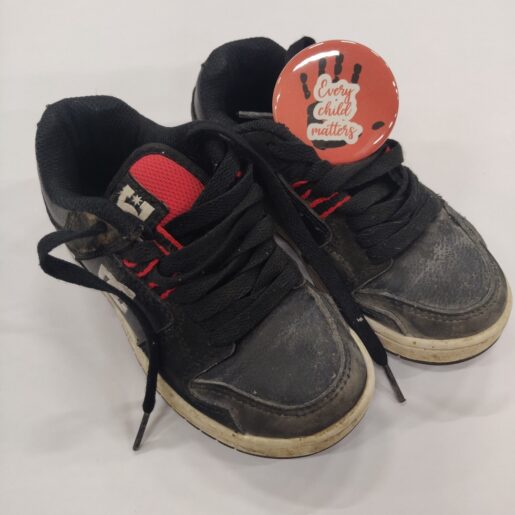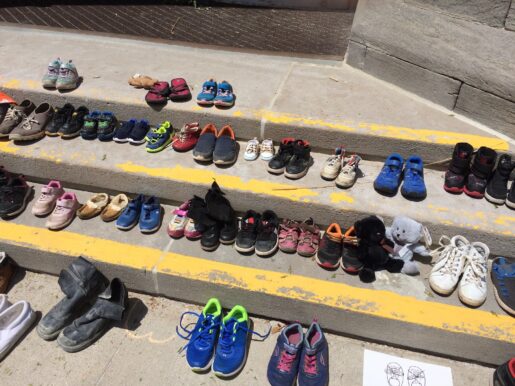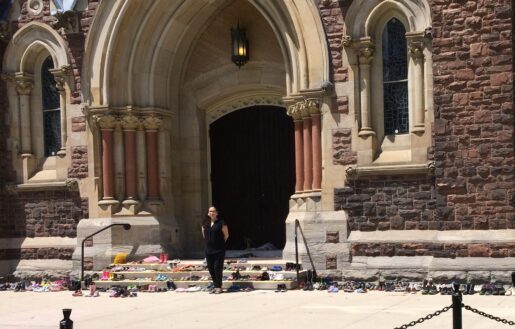
Boys’ DC Sneakers, 2020. Button “Every Child Matters”, 2021. Gifts of Lela George, 2021
Lela George, spirit name Yeyatalunyuhe, discusses her new donation to Museum London's collection. This conversation between Lela and our Curator of Regional History took place on June 1, 2021 at a memorial for Indigenous children, which Lela organized, outside St. Peter’s Basilica in London, Ontario. Lela put the callout on Facebook for people to join her and place shoes on the steps of the church to mark the discovery and loss of children at Residential Schools across Turtle Island / North America. This interview has been edited for length.
Yeyatalunyuhe George: My name is Lela George. My spirit name is Yeyatalunyuhe.
Amber Lloydlangston (Curator of Regional History): Thank you so much. Now we’re standing here outside St. Peter's Basilica and we’re looking at the memorial of shoes, children’s shoes, placed to mark the discovery and loss of the 215 children at the residential school in BC. Now you were the organizer of this memorial. Can you talk to me a little bit about doing that?
YG: Yes. I saw the callout across Turtle Island, as you know as the United States or North America and it was discovered that there was 215 children, as young as three-years-old, in a mass grave. And so I just took the lead because it hits home for me. I come from a family that has residential school survivors. My partner, as well, has grandparents that are here and are survivors themselves. So I put the callout on Facebook and I asked people to join me to have a memorial for these young children who have yet to be named.
AL: Now you’ve been kind enough to offer the pair of shoes that you’ve left to Museum London for addition to our collection. Was there a reason that you chose those, that particular pair of shoes? Is there anything there?
YG: Well, my son. He’s six-years-old and those are his shoes. He’s outgrown them but we still have them. So I chose his because he is a special needs child and when I was going through all of these thoughts in my head of these children and what they went through, he hits my heart a little bit more because he’s global development delay. He has the mind of a three-year-old. He can’t speak, I guess, like an average child can. He speaks but in his own different way. He signs with his hands and made up his own way of communication. And when I thought about these children being taken from their homes and how young, he came to mind as, you know, if we were back then, what would happen to him, being a child that does not have a voice? And so I decided to lay his shoes down because I think about those children and I think about those children that were found that did not have a voice and now, with their discovery of the remains, we are their voice years later.

AL: What’s your son’s name if you want to share it? Only if you want to.
YG: His name is Jordan and he is…we’re Wolf clan from Six Nations. I’m trying to remember his spirit name. It’s been a while since I said it. I can’t…
AL: That’s okay. If you remember it later that’s fine. So you said you’re Wolf clan, Six Nations. Could you give just a little bit of background as to your origin, where you’re from?
YG: Well, my mother’s line, we go through as Haudenosaunee, we call it, and that’s Mohawk for “People of the Longhouse” or “We are the House” and my family, my mother’s line is from Six Nations. My mother’s line were cooks in the residential schools and my great grandmother was a teacher. It’s actually recorded on line in a book that I found that her and Emily C. General, who was also Six Nations, they share what it’s like being a woman in those times and they share about having to choose either to be an office clerk or a teacher and a lot of the women chose to be teachers or they preferred to be teachers because they were closer to their children and that gave them a chance to teach them language and ceremony and all the things that were forbidden underground.
So for me it hits home because my grandparents, or my grandmother, they were also voices of their times and I didn’t know this until I got older, until I became a voice, and discovered my own voice, that it’s kind of in my DNA, I guess. I feel like it’s imprinted on my DNA and I didn’t know until later.
So another reason, my father, who passed on last year, his father was a residential school survivor. He couldn’t read or write. He had scars on his back and on his bottom from residential school. He suffered with alcoholism…abuse, was very abusive to my aunt and my father growing up because of the things that had happened to him. They really pushed Christianity with me, my father did with me because his father did with him so he was really afraid to learn or even talk about our culture and language, our medicines, which is our four medicines are cedar, sage, sweetgrass, and tobacco. And so right up until he passed away, he really didn’t experience his culture, literally right until he passed away, we brought in some ceremony. He was able to experience that. But it hit home for me because I feel robbed of that…sorry...
AL: You’re good. Take your time.
YG: …just knowing how afraid my dad was of our ways and how that fear was instilled in him and his father, you know, he would get beaten because…for instance, I shared that he drew a dinosaur on a paper. And my dad said it was just a dinosaur and his mother saw it and thought it was the devil and so he got beaten for drawing that picture.
So when people say this is part of our history, it’s not history and I’m realising that right now. And talking more and more about this, it really isn’t history. This is our lives now and I’m unlearning the things that our parents and grandparents had learned because of residential schools. It’s definitely a process, definitely a healing process and just being able to become a loving mother and to give love and receive love and do that with my own children, breaking cycles, and it’s kind of starting new, new paths and opening new doorways as far as culture and ceremony go, for me anyway, and I know for a lot of people that were also triggered by this discovery.
AL: Right. Right. Now I know that descent is traced through the female line in…where is your father from, just…
YG: My father is registered Oneida but his mother was Ojibwe from Saugeen and Saugeen Ojibwe follow their father so he’s Bear clan on both sides. But my mother is, her rights were disenfranchised when she was younger so she’s registered Oneida still but her traditional matrilineal line is Mohawk from Six Nations.
AL: Do you know which residential schools your family members might have…
YG: The Mush Hole, which is Mohawk Institute, I believe at Six Nations. There’s that one and then I believe it’s Carlyle is the one my grandfather attended and he attended until he was 21-years-old and he worked on the farms. My dad told me he would have to get up at 3:30 in the morning to milk the cows and not even have anything to eat before doing that. I never met…no, I actually did meet him when I was really young but the only memory I have of him is drinking on a porch. He suffered a lot with addiction and alcoholism. And just growing up, you don’t understand why. It’s like you’re growing up and you’re grieving and you don’t understand why. I grew up with grandma telling me, “Don’t you know that you’re an Indian?” and really trying to understand what that meant because I was…I had to go to church a lot as a child and the only way I really learned my culture was in bits and pieces in the day school still on Oneida because I went to day school. And so listening to the Bible creation story and then hearing our own creation story, it was very confusing to me growing up, and I honestly felt like, for a very long time, I wasn’t Indian enough. I felt very separated from my people and my community and as I got older my spirit called me to that. And as I started my own healing journey from addictions, alcoholism, it was that that saved my life: culture, ceremony, and just being a part of that saved my life.

AL: And does this memorial help in healing? I imagine it has to be a continual process right? You don’t just heal and it’s done.
YG: Yeah, I find that I’ve lived my whole life only being 37-years-old, that I’ve lived a life that’s always been trauma and healing, trauma and healing, but putting this callout, even though it’s a terrible tragedy, it’s also…I feel kind of at peace because the children were found. It’s a validation that it did happen. We’re not making this stuff up. It really is, it’s happening now, it’s still here. But, it’s definitely…it brought a lot of people together that I wouldn’t normally see at the actions that I plan because I’ve done a few over the past few years. I feel like we put everything aside and we were able to be there for each other and understand, all things aside, we can all relate to this and we can all just stand and be there for each other and comfort each other and educate.
AL: Do you have anything else you want to add that I haven’t asked since this is so impromptu?
YG: Well, I don’t think that this is going to be the last. I think that there’s many more areas that need to be investigated. I think that $1.5 million isn’t all that much money compared to how much money Trudeau has handed out to many other things especially over the past two years. $1.5 million isn’t really that much to investigate and to honour those lives that haven’t been found yet because they will be one day and I believe that there’s many more areas that need to be searched over and the children, the young boys and girls, they deserve that. They deserve that. They deserve to be found. They deserve to have names. They deserve to have a memorial that is there permanently for all children, survivors here that have been found and have not been found.